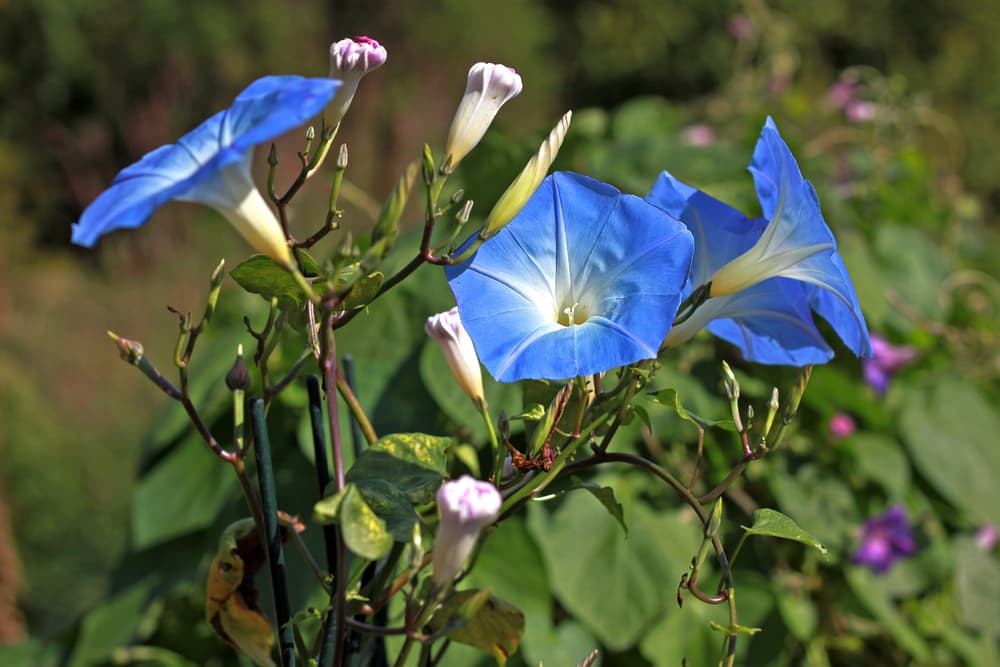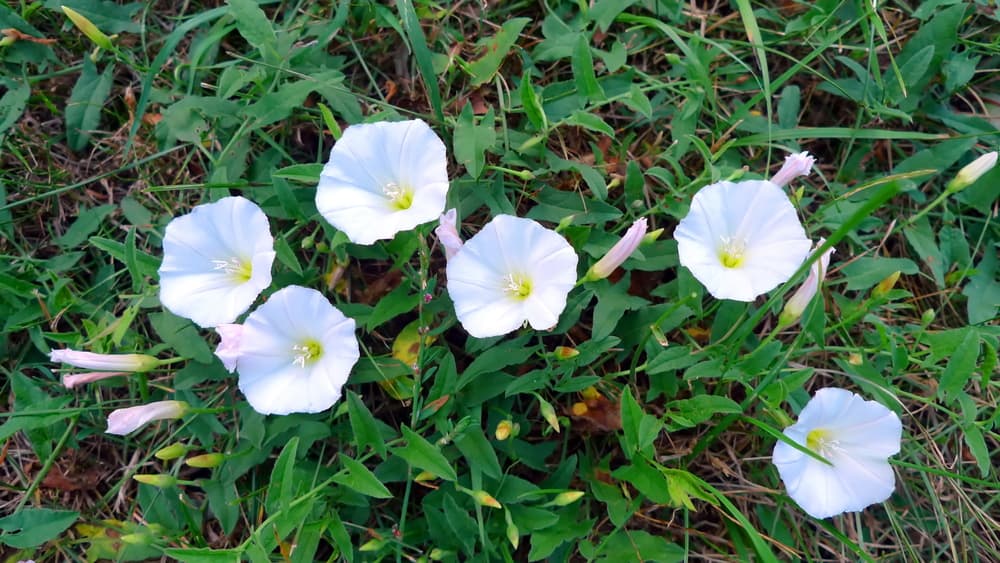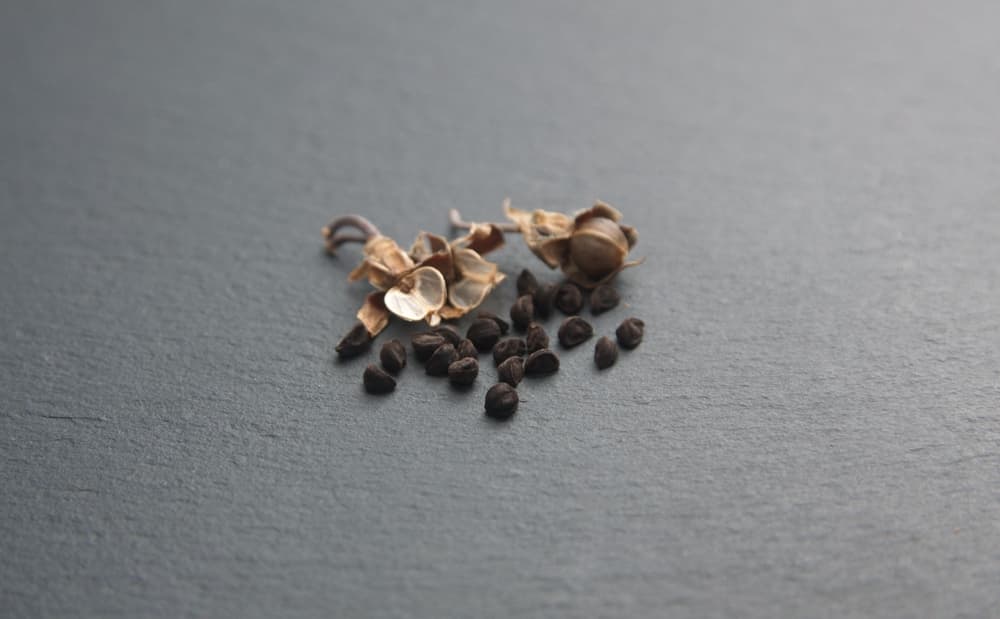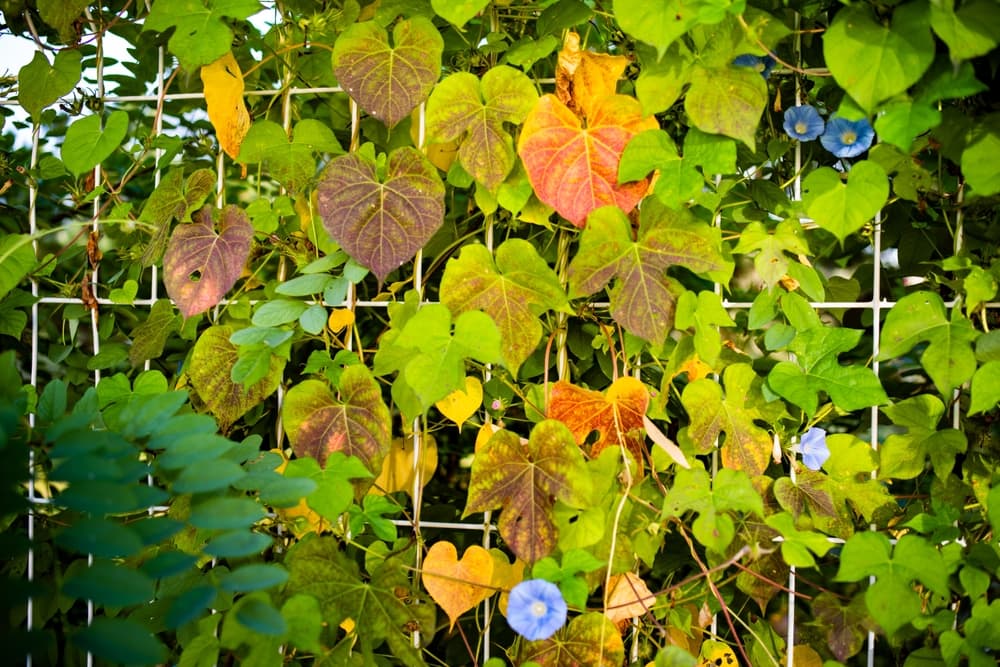Why And How To Grow Morning Glory – There Can Be Some Confusion With Species

CLIMBERS > IPOMOEA

Elizabeth is a Permaculture Garden Designer, Sustainability Consultant and Professional Writer, working as an advocate for positive change. She graduated from the University of St. Andrews with an MA in English and Philosophy and obtained a Diploma in Applied Permaculture Design from the Permaculture Association.
Reviewed By COLIN SKELLY

Colin is a Horticulturist and Horticultural Consultant with experience in a range of practical and managerial roles across heritage, commercial and public horticulture. He holds the Royal Horticultural Society’s Master of Horticulture award and has a particular interest in horticultural ecology and naturalistic planting for habitat and climate resilience.
IN THIS GUIDE
IPOMOEA GUIDES
‘Morning Glory’ is a name given to a number of different plants – many of which have similar appearances but very different growing properties.
In this guide, we’ll focus on Ipomoea purpurea and Ipomoea tricolor – annual climbing plants, which are popular with UK gardeners.
We’ll also take a look at some other ‘Morning Glories’ along the way.
Overview
| Botanical Name | Ipomoea |
| Common Name(s) | Morning Glory |
| Plant Type | Climber |
| Native Area | Mediterranean |
| Hardiness Rating | H3 |
| Foliage | Deciduous |
| Flowers | Large, various colours |
| When To Sow | March, April |
| Plant Out | May, June |
| Flowering Months | June, July, August, September |
Sunlight
Preferred
Full Sun
Exposure
Sheltered
Size
Height
0.1 – 0.5M
Spread
0.1 – 0.5M
Bloom Time
Summer
Soil
Preferred
Sand
Moisture
Well-drained
pH
Any
Over a thousand different plants within the Convolvulaceae plant family are referred to as ‘Morning Glory’.1The Editors of Encyclopaedia Britannica. (1998e, July 20). Convolvulaceae | Description & Major Species. Encyclopedia Britannica. Retrieved March 21, 2023, from https://www.britannica.com/plant/Convolvulaceae
Many of these are within the Ipomoea genus, though there are also Morning glory plants from many other genera including Argyreia, Calystegia, Convolvulus and more.
In UK gardens, two of the most popular morning glory plants are I. purpurea and I. tricolor.
I. purpurea, also referred to as ‘Common Morning Glory’, ‘Purple Morning Glory’ or ‘Tall Morning Glory’ – is a climber native to Central and Southern America.2Ipomoea purpurea. (n.d.). Kew Royal Botanic Gardens. Retrieved March 21, 2023, from https://powo.science.kew.org/taxon/urn:lsid:ipni.org:names:30043043-2

Another climbing native of the new world tropics, I. tricolor is also popular in UK gardens.

Both of these can be perennial in their native ranges, and in warmer climes, but are almost always grown as annuals in the UK’s climate.
Confusion occurs because ‘Morning Glory’ is sometimes a term also used to refer to a couple of common weeds found here in the UK:
Calystegia sepium (hedge bindweed or wild morning glory) and Convolvulus arvensis (field bindweed, perennial morning glory or small-flowered morning glory) can be problematic weeds in some gardens.

They can spread very rapidly and outcompete or choke other plants.
And confusion is compounded by the fact that common garden Ipomoea morning glory species can also be invasive ‘problem weeds’ in some regions of the US and elsewhere, though they do not tend to pose an issue in the UK.3Field Bindweed (aka Morning Glory). (2009, September). King County Noxious Weed Control Program Weed Alert. Retrieved March 21, 2023, from https://www.nwcb.wa.gov/pdfs/Bindweed_factsheet_King.pdf
Why Grow Morning Glory?
Assuming that most gardeners will not wish to grow the bindweeds mentioned above in their gardens, in the rest of this article we will focus on how to grow the two main species of climber mentioned above as ornamental annuals in your garden.
These annuals are popular choices with UK gardeners because they are fast-growing plants which bloom attractively through summer and into early autumn.
As the name suggests, morning glory plants flower early in the day – blooms appear just for a single morning before fading away in the afternoon – but many flowers are borne in succession, so plants will create lovely displays for a number of months.
These blooms can be up to around 8cm across, and come in a range of different colours, from purples and blues, through pinks and reds.
Some cultivars have bi-coloured petals.
Common Varieties

Some excellent morning glory options to consider growing include:
- I. purpurea ‘Grandpa Ott’
- I. purpurea ‘Ensign Rose’
- I. purpurea ‘Party Dress’
- I. purpurea ‘Scarlet O’Hara’
- I. purpurea ‘Lazy Luxe’
- I. purpurea ‘ Sunpuma Purple Princess’
- I. purpurea ‘Star of Yelta’
- I. tricolor ‘Heavenly Blue’
- I. tricolor ‘Flying Saucers’
- I. ‘Hazelwood Blues’

How To Grow Morning Glory
Ipomoea morning glory climbers need a sunny and sheltered spot.
These plants do best in moist but well-drained soil.
They can also be grown in containers, as long as they are provided with suitable support.

Support
As climbers, they will of course need some form of support to scramble up.
An established shrub or conifer can be used in certain settings as a natural trellis support.
However, more commonly, Morning glory will be grown up free-standing obelisk type supports, or up a trellis on a sunny wall or fence.
Container Growing
Even if you do not have any outside space at all, these morning glories can be grown as a container plant in a sunny porch or conservatory, or in another sunny spot inside your home.
When grown indoors, these can sometimes act as short-lived perennials as they do in their native range.
Sowing
If you want to grow morning glory in your garden then you will most likely have to grow your plants from seed, as mature plants are rarely available for sale.

I. tricolor requires a long growing season, so you should sow your seeds in early-to-mid spring, indoors.
- Before you sow your seeds, to increase the chances of successful germination, it is a good idea to soak the seeds overnight. The water will soften and break down the hard coating on the seeds and make them more likely to sprout successfully.
- Sow the seeds around 1cm deep, in a moist seed-starting potting mix.
- They will need to be kept in a warm spot until germination has taken place – so using a propagator is ideal.
- I. purpurea can be sown indoors, as above, but can also be sown in spring where it is to grow.
- If you have sown under cover, once the seedlings emerge and are large enough to handle, pot them up into their own individual pots.
- Use small, thin canes inserted in the soil of each pot to give the baby climbers something to cling to.
Be sure to harden off your indoors grown plants before placing them outdoors into their final growing positions if you will be placing them outdoors.
Planting
Morning glory that has been sown and grown indoors should not be placed out before late May or early June.
“Do not be tempted to plant out too early, however much some early spring sunshine tempts you into it,” says Master Horticulturist Colin Skelly.
“Overnight frosts can occur well into May across the UK but especially in the north.
“It’s happened to me a few times and I now like to think that I’ve learned (the hard way).
“Wait until into June and the extra soil warmth will also help to get your Morning Glory off to a strong start once outside.”

Make sure supports are in place before planting your morning glory in the ground or in containers.
If growing in a container, place 3-5 morning glory plants around the edges of a large pot – this should ideally be at least 40cm wide and 40cm deep.
The container should be filled with good quality, peat-free multi-purpose potting mix, top dressed with organic matter such as homemade compost or leaf mould, for example.
Water your plants in well, and gently wind the stems of the plants into their new supports.
Plant Care
Watering
Water should be provided as required to keep the soil or potting medium evenly moist.
But you should take care not to overwater as these plants will definitely not thrive in waterlogged conditions.
Feeding
Especially when growing in pots, and for best results when growing in the ground, you should also feed morning glory with a high potassium organic liquid plant feed (such as a comfrey tea, for example) every couple of weeks or so once the first flowers arrive.
Training
These climbers will generally climb up and twine around their supports on their own.

Occasionally, however, you will need to give them a little helping hand to make sure they head in the right direction.
Check every few days and if stems have gone astray, guide them gently back onto their supports.
Deadheading & Pruning
Deadheading the flower heads will encourage new blooms to form over the summer months.
No pruning is required, but you can if you wish snip off the growing tip once the plant reaches the top of the support.
This can also encourage new shoots to emerge lower down.
Growing morning glory can give you impressive annual blooms over a relatively long period, and quickly cover support structures over the summer months.
Though there are definitely some morning glory plants (bindweeds) which can pose a problem in your garden, these ornamental plants are definitely a plus for your garden.
References
- 1The Editors of Encyclopaedia Britannica. (1998e, July 20). Convolvulaceae | Description & Major Species. Encyclopedia Britannica. Retrieved March 21, 2023, from https://www.britannica.com/plant/Convolvulaceae
- 2Ipomoea purpurea. (n.d.). Kew Royal Botanic Gardens. Retrieved March 21, 2023, from https://powo.science.kew.org/taxon/urn:lsid:ipni.org:names:30043043-2
- 3Field Bindweed (aka Morning Glory). (2009, September). King County Noxious Weed Control Program Weed Alert. Retrieved March 21, 2023, from https://www.nwcb.wa.gov/pdfs/Bindweed_factsheet_King.pdf
